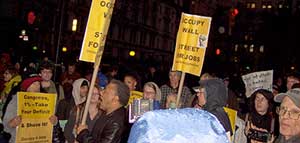Protesters hold series of brief bank occupations on Wall Street
By
Tony Murphy
New York
Published Dec 3, 2011 10:23 AM
When New York City mayor, Michael Bloomberg, effectively ended the Occupy Wall Street encampment at Zuccotti Park on Nov. 15, many wondered if the movement had been weakened.
|
WW photo: John Catalinotto
|
Just two days later, several actions took place on the “Historic Day of Action for the 99 Percent.” Thousands of New Yorkers rallied at the Stock Exchange. Later that day, thousands more occupied a building near the New School. That afternoon, more than 32,000 people marched from Foley Square across the Brooklyn Bridge.
It is clear that regardless of location, the Occupy movement is alive and well. OWS has not only survived, it has given birth to a new movement and is encouraging more people to get out on the streets.
One of the formations inspired by the Occupy movement is the Occupy 4 Jobs Network, which held its first actions in New York City and Philadelphia on Nov. 23 to protest against the fraudulent congressional “super committee,” whose goal it was to cut $1.2 trillion over 10 years from the federal budget, which would harm working and poor people.
During the New York action, Larry Holmes, Occupy 4 Jobs organizer, told Reuters television, “We’ve got 30 million people in this country who are either unemployed or underemployed and they need jobs. And so we’re here to say that from now on, until the government begins dealing with that painful reality, unemployed people and their supporters are going to start occupying things.” He stressed, “We left our calling card.” (Nov. 23)
Occupy 4 Jobs was launched at a meeting in the South Bronx at Hostos Community College on Nov. 2. The initial call stated its explicit debt to and inspiration from OWS and its goal of opening up a new front: the struggle against the jobs crisis. The organization is calling for a massive public works program and the right to a job or income.
In its first New York actions last week, Occupy 4 Jobs, joined by members of the Occupy Wall Street Working Group on Unemployment and the Bail Out the People Movement, held a series of brief bank occupations in the Wall Street area.
Protesters gathered at Zuccotti Park with placards that said, “Occupy Wall Street for Jobs!” “Congress, 1% — Take Your Deficit and Shove It!” and “We Want Work — And We’re Fighting Mad.” The group then headed down Broadway. Twenty protesters headed into a Citibank branch, chanting, “Money for jobs, not for banks!” and “No jobs, no peace!” When half a dozen “community affairs” cops entered the bank, the protesters left and headed to a Chase branch.
After police presence increased at Chase, only two activists were able to get into the bank. The rest rallied in the ATM area. Nevertheless, the bank manager closed the branch before the posted closing time, and called to a “white-shirt” cop, a member of the police brass, to join the other cops to get the two protesters to leave.
The demonstrators then headed further south on Broadway towards the huge, metal, Wall Street bull sculpture. By this time, motorcycle cops had arrived and lined the edge of the march. The protesters then reversed course and went north on Broadway to a Fidelity Savings branch. Cops blocked this entrance completely. Wall Street was to experience no further mini-occupations that night.
These mini-occupations displayed the militant and flexible tactics that Occupy 4 Jobs will be employing in the fight for jobs.
The organization’s original call said, “Occupations need not be the only tactic of the Occupy 4 Jobs Network. The word ‘occupy’ has now taken on a broader meaning than its literal definition. ‘Occupy’ now means ‘fight back.’ It means self-determination, and in the words of Malcolm X, it means fighting ‘by any means necessary.’”
For news of upcoming actions, see www.occupy4jobs.org.
Articles copyright 1995-2012 Workers World.
Verbatim copying and distribution of this entire article is permitted in any medium without royalty provided this notice is preserved.
Workers World, 55 W. 17 St., NY, NY 10011
Email:
[email protected]
Subscribe
[email protected]
Support independent news
DONATE


